每天推薦一個 GitHub 優質開源項目和一篇精選英文科技或編程文章原文,歡迎關注開源日報。交流QQ群:202790710;電報群 https://t.me/OpeningSourceOrg
今日推薦開源項目:《飛冰(ICE)快速構建中後台應用》
推薦理由:飛冰(ICE)是一套基於 React 的中後台應用解決方案,幫助用戶快速搭建中後台應用。為了釋放開發人員在中後台應用開發中的重複勞動,解放生產力提升效率。ICE 由淘寶前端發起,目前已經在阿里巴巴集團內部多個 BU 中應用,形成了一個從設計到開發的完整鏈路,並在這一過程中提供全程答疑輔導。
特點
https://alibaba.github.io/ice ICE 官網介紹了全套的方案,在這裡總結幾點。
工具鏈:
ICE 提供了 Iceworks 工具幫助開發人員進行項目構建和頁面搭建,搭建工具提供了 MacOS 和 Window 兩個系統的版本。工具提供了可視化的頁面構建工具,並將淘寶的 React 最佳實踐的思路應用其中。同時也提供了非 GUI 的命令行構建工具與腳手架,方便多種形式進行開發。提供了 Playground 工具用於快速驗證想法實現 demo 和復現 bug。
組件庫:
ICE 依託內部的 Fashion 組件庫(阿里內部使用,即將開放)提供了 button, radio, select 等等基礎組件。在底層的基礎組件之上構建了一些區塊,這些區塊比如圖表,消息列表,登陸頁等等,這些區塊涵蓋了大部分的中後台應用場景,這些也是在淘寶中後台大量應用的。在區塊之上,根據各種區塊的拼接加頁面的布局結構形成了一些固化的模板。在提供精緻的中後台模板的同時又不丟失各個級別的靈活度。

學習與資源:
提供專業的學習平台和領域解決方案,並提供實時答疑與輔導。ICE 對外輸出的不僅僅是一套技術上的方案,是一種服務和態度的輸出。ICE 目標是將前端中後台構建技術輸出給外部企業和開發人員,要做到這樣不僅僅是開源代碼,給出一些開發文檔這樣而已,需要去精心呵護,沉下心來去幫助,做到真正的賦能。
討論
在知乎上搜索 ICE (https://www.zhihu.com/search?type=content&q=ice)有很多關於其的討論,當然看法褒貶不一。
小編的見解:現有各個企業的中後台系統中肯定還包含有各種奇奇怪怪充滿個性的組件可能是 ICE 沒有實現的,可能還有各種奇葩的需求是 ICE 沒有碰到過的,但是我相信隨著 ICE 的開放和社區慢慢地形成,這些問題會一個一個被解決,物料庫也會越來越豐富。UI 層面出現過各種各樣的基於某個框架的組件庫,但是很少有像 ICE 一樣開放一個完整的前端應用構建的工作鏈路。ICE 的出現勢必將幫助非常多的開發人員節省開發時間提高效率,這是毋庸置疑的,同時我還相信他們能做好賦能企業中後台建設這一件事。
今日推薦英文原文:《A gentle introduction to FreeDOS》作者:Jim Hall
原文鏈接:https://opensource.com/article/18/4/gentle-introduction-freedos
推薦理由:一份輕鬆優雅的 FreeDOS介紹。雖然 FreeDOS 是一款很老的操作系統,但是對很多人來說卻很新很稀奇,早在1994年,這款項目就開始了,目標是創建一個完全自由的、與DOS兼容的操作系統,同時能運行 DOS 下的經典遊戲和一些傳統的商業軟體,以及一些嵌入式操作系統。
A gentle introduction to FreeDOS
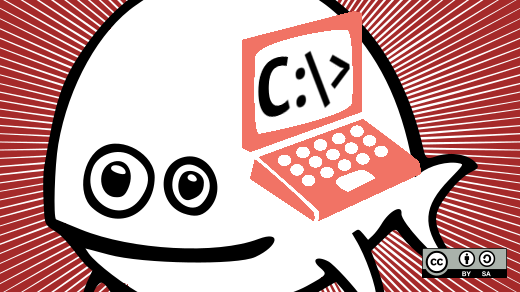
FreeDOS is an old operating system, but it is new to many people. In 1994, several developers and I came together to create FreeDOS—a complete, free, DOS-compatible operating system you can use to play classic DOS games, run legacy business software, or develop embedded systems. Any program that works on MS-DOS should also run on FreeDOS.
In 1994, FreeDOS was immediately familiar to anyone who had used Microsoft's proprietary MS-DOS. And that was by design; FreeDOS intended to mimic MS-DOS as much as possible. As a result, DOS users in the 1990s were able to jump right into FreeDOS. But times have changed. Today, open source developers are more familiar with the Linux command line or they may prefer a graphical desktop like GNOME, making the FreeDOS command line seem alien at first.
New users often ask, "I installed FreeDOS, but how do I use it?" If you haven't used DOS before, the blinking C:\> DOS prompt can seem a little unfriendly. And maybe scary. This gentle introduction to FreeDOS should get you started. It offers just the basics: how to get around and how to look at files. If you want to learn more than what's offered here, visit the FreeDOS wiki.
The DOS prompt
First, let's look at the empty prompt and what it means.
DOS is a "disk operating system" created when personal computers ran from floppy disks. Even when computers supported hard drives, it was common in the 1980s and 1990s to switch frequently between the different drives. For example, you might make a backup copy of your most important files to a floppy disk.
DOS referenced each drive by a letter. Early PCs could have only two floppy drives, which were assigned as the A: and B: drives. The first partition on the first hard drive was the C: drive, and so on for other drives. The C: in the prompt means you are using the first partition on the first hard drive.
Starting with PC-DOS 2.0 in 1983, DOS also supported directories and subdirectories, much like the directories and subdirectories on Linux filesystems. But unlike Linux, DOS directory names are delimited by \ instead of /. Putting that together with the drive letter, the C:\ in the prompt means you are in the top, or "root," directory of the C: drive.
The > is the literal prompt where you type your DOS commands, like the $ prompt on many Linux shells. The part before the > tells you the current working directory, and you type commands at the > prompt.
Finding your way around in DOS
The basics of navigating through directories in DOS are very similar to the steps you'd use on the Linux command line. You need to remember only a few commands.
Displaying a directory
When you want to see the contents of the current directory, use the DIR command. Since DOS commands are not case-sensitive, you could also type dir. By default, DOS displays the details of every file and subdirectory, including the name, extension, size, and last modified date and time.

If you don't want the extra details about individual file sizes, you can display a "wide" directory by using the /w option with the DIR command. Note that Linux uses the hyphen (-) or double-hyphen (--) to start command-line options, but DOS uses the slash character (/).

You can look inside a specific subdirectory by passing the pathname as a parameter to DIR. Again, another difference from Linux is that Linux files and directories are case-sensitive, but DOS names are case-insensitive. DOS will usually display files and directories in all uppercase, but you can equally reference them in lowercase.
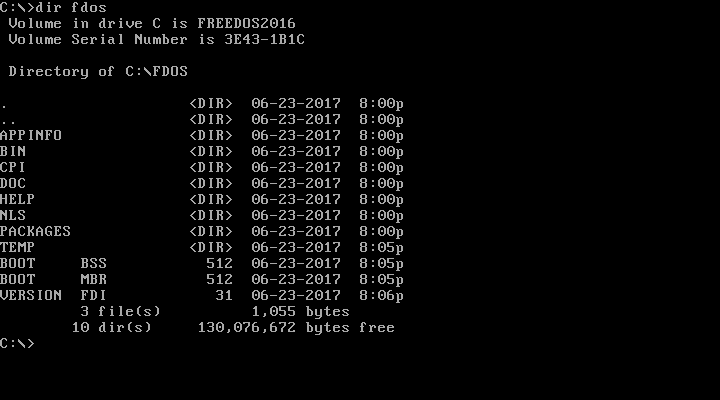
Changing the working directory
Once you can see the contents of a directory, you can "move into" any other directory. On DOS, you change your working directory with the CHDIR command, also abbreviated as CD. You can change into a subdirectory with a command like CD CHOICE or into a new path with CD \FDOS\DOC\CHOICE.
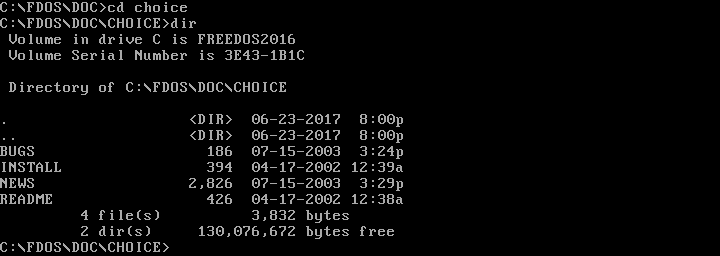
Just like on the Linux command line, DOS uses . to represent the current directory, and .. for the parent directory (one level "up" from the current directory). You can combine these. For example, CD .. changes to the parent directory, and CD ..\.. moves you two levels "up" from the current directory.
FreeDOS also borrows a feature from Linux: You can use CD - to jump back to your previous working directory. That is handy after you change into a new path to do one thing and want to go back to your previous work.
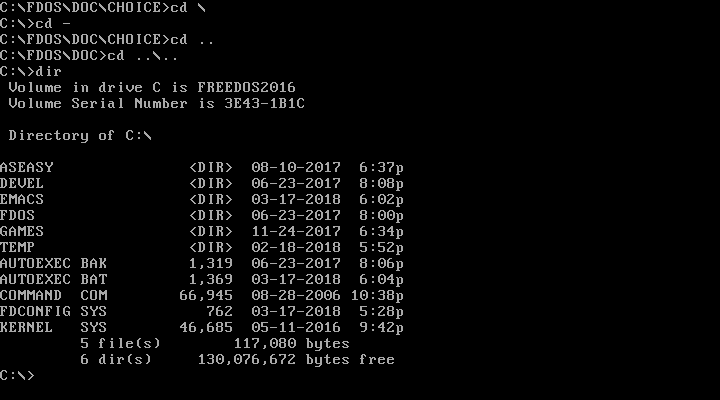
Changing the working drive
Under Linux, the concept of a "drive" is hidden. In Linux and other Unix systems, you "mount" a drive to a directory path, such as /backup, or the system does it for you automatically, such as /var/run/media/user/flashdrive. But DOS is a much simpler system. With DOS, you must change the working drive by yourself.
Remember that DOS assigns the first partition on the first hard drive as the C: drive, and so on for other drive letters. On modern systems, people rarely divide a hard drive with multiple DOS partitions; they simply use the whole disk—or as much of it as they can assign to DOS. Today, C: is usually the first hard drive, and D: is usually another hard drive or the CD-ROM drive. Other network drives can be mapped to other letters, such as E: or Z: or however you want to organize them.
Changing drives is easy under DOS. Just type the drive letter followed by a colon (:) on the command line, and DOS will change to that working drive. For example, on my QEMU system, I set my D: drive to a shared directory in my Linux home directory, where I keep installers for various DOS applications and games I want to test.
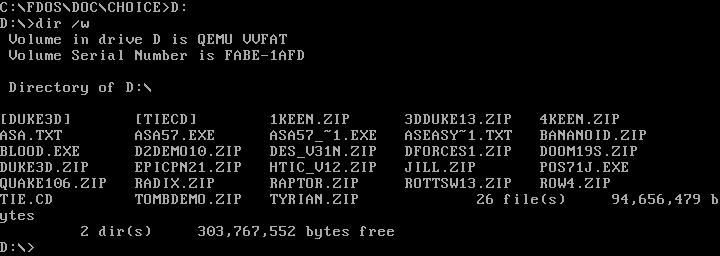
Be careful that you don't try to change to a drive that doesn't exist. DOS may set the working drive, but if you try to do anything there you'll get the somewhat infamous "Abort, Retry, Fail" DOS error message.

Other things to try
With the CD and DIR commands, you have the basics of DOS navigation. These commands allow you to find your way around DOS directories and see what other subdirectories and files exist. Once you are comfortable with basic navigation, you might also try these other basic DOS commands:
MKDIRorMDto create new directoriesRMDIRorRDto remove directoriesTREEto view a list of directories and subdirectories in a tree-like formatTYPEandMOREto display file contentsRENAMEorRENto rename filesDELorERASEto delete filesEDITto edit filesCLSto clear the screen
If those aren't enough, you can find a list of all DOS commands on the FreeDOS wiki.
In FreeDOS, you can use the /? parameter to get brief instructions to use each command. For example, EDIT /? will show you the usage and options for the editor. Or you can type HELP to use an interactive help system.
Like any DOS, FreeDOS is meant to be a simple operating system. The DOS filesystem is pretty simple to navigate with only a few basic commands. So fire up a QEMU session, install FreeDOS, and experiment with the DOS command line. Maybe now it won't seem so scary.
每天推薦一個 GitHub 優質開源項目和一篇精選英文科技或編程文章原文,歡迎關注開源日報。交流QQ群:202790710;電報群 https://t.me/OpeningSourceOrg


Ppl like you get all the brasni. I just get to say thanks for he answer.